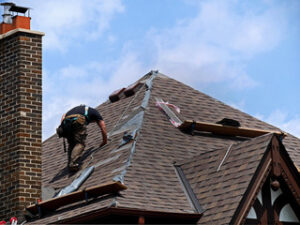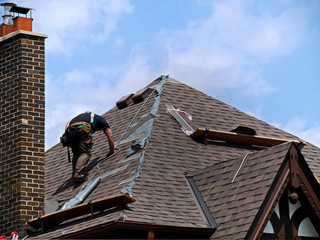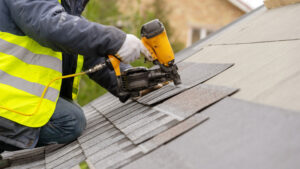Regular roof inspections and maintenance are a must for homeowners to avoid costly water damage. Missing or broken shingles, caulking issues and vent leaks are just a few warning signs that should be addressed immediately.
 Regularly inspecting, cleaning, and clearing debris can prevent long-term issues such as mold, lichen, and moss growth. Roofing Company also ensures that gutters and downspouts are clogged-free and that ventilation works properly.
Regularly inspecting, cleaning, and clearing debris can prevent long-term issues such as mold, lichen, and moss growth. Roofing Company also ensures that gutters and downspouts are clogged-free and that ventilation works properly.
A roof inspection is a vital step in any maintenance program and one of the most important tasks a roofing contractor can do for their clients. They will check the shingles, gutters, downspouts, and ventilation to identify issues before they become costly repairs. A professional roofing contractor will also look for other problems that can compromise a roof’s lifespan, such as water damage, mold, mildew, or leaks.
While some homeowners can inspect their own roofs, having a professional do it for you at least once a year is generally recommended. It is best to do this in the spring or fall, as this is when the weather conditions are moderate. However, it is important to have your roof inspected after any extreme weather events or incidents as well.
During a roof tune-up, the roofing contractor will fully inspect the entire roofing system. This will include a detailed inspection of flashings (this is a common source of leaks) at skylights, perimeters, walls, penetrations, equipment curbs, and drains. They will re-caulk seams, replace leaking shingle tabs, remove debris, and make general repairs.
Roofers can also help you to spot issues that you may not have noticed, such as ominous brown spots on the ceiling or damp walls. This can indicate a serious problem that needs to be addressed quickly. In addition, they will be able to inspect the ventilation of the attic and ensure there is no blockage in the ridge vents which can lead to delamination of the plywood decking.
When it comes to a residential home, many roofing companies offer a subscription service which will involve the routine inspection and maintenance of your roof. These services are designed to prolong the life of your roof and keep it looking its best. This is an investment worth making, considering your roof is the first line of defense between you and the outside elements.
Professional roofers also offer services for commercial buildings and can set up a schedule of maintenance to extend the life of your roof. These services can also help you to comply with occupational health and safety laws, which require that your roof be in good condition. A commercial roofing contractor will also be able to give you a comprehensive record of your roof system’s condition, which will be invaluable when it comes time to sell or purchase the building.
Cleaning
The roof of your home may be the last thing on your mind, but it is one of the most important components to keep in good shape. Cleaning it helps to prevent damage caused by debris, dirt, plant growth, and moss or algae.
A clean, moss-free roof not only looks great but also protects the integrity of your roofing system. Ideally, you should have your roof cleaned twice per year in order to keep it looking its best and performing at its optimal level.
It is always best to hire a professional company to perform roof cleaning, as it requires significant safety and technical expertise. However, if you wish to do it yourself, it is essential that you use the right equipment and follow proper procedures.
You should wear slip-resistant shoes, rubber gloves and a safety harness to ensure that you can safely climb the roof. You should also let someone know where you are going to be, so that they can alert emergency services in case of an accident. If you have a slanted roof, it is especially crucial that you wear a harness and secure it to the chimney or some other anchor point so that you don’t fall off.
The first step in cleaning the roof is to remove any debris. A leaf blower or hand-held vacuum is suitable for this purpose. You should also clear any branches or leaves from the gutters and downspouts.
Once you have removed any debris, you can begin to spray the roof. You should start from the bottom and work your way up, saturating each area with the cleaner. Be sure to pay special attention to the crevices and undersides of shingles.
After the cleaning process, you should allow the chemicals to dry thoroughly before climbing onto your roof. Generally, this should take between two and five hours. It is also recommended that you cover surrounding plants and furniture with tarps to avoid any chemical runoff or staining.
A common cleaner for shingle roofs is a solution containing trisodium phosphate (TSP). TSP can be bought at grocery stores in concentrations of up to 5.75%, but professionals are usually able to get a higher concentration and thereby achieve better results.
Repairs
As roofs age, they will likely require repairs. Some issues can be repaired with roofing cement and nails, while others will require a professional roofer to replace the damaged materials and reseal. The type of repair will determine the cost, with replacing shingles and other cheaper materials costing less than repairing support trusses or other more expensive roof materials.
Holes
If there is a hole in the roof, it should be fixed promptly to avoid moisture intrusion into the house. This can be a simple patch job for a roofer or a more extensive project, depending on the size of the hole.
Broken Shingles
Over time, shingles and tiles will deteriorate and lose pieces or granules, leaving the lower surfaces exposed to the elements. Keeping an eye out for these granules in the gutters can help homeowners know when it’s time to call in the pros for repairs or replacements.
Flashing Issues
The flashing, or thin sheet metal, around chimneys, pipes, and other structures on a roof is designed to direct water away from those areas. Periodically checking these areas can prevent leaks and other roofing problems.
Checking the flashing can also include looking for cracks, missing sealant, or other problems. For instance, if the flashing is bent, it can break the roof’s seal and lead to leaks. Bending the flashing back into place and resealing it may be a DIY project, but if the flashing is seriously cracked or rusted, it will need to be replaced with new material.
Look for other signs of damage or rot, such as the need to clean organic debris from gutters and leaders, water stains in the ceilings and walls, and the presence of insects or animals. Also, consider whether it’s time to replace the fascia boards. These long wooden boards protect the edges of a roof and can be vulnerable to water damage, animal infestation, and mold growth.
Other structural repairs can include replacing or repairing roof vents and skylights. The latter are more expensive to replace than shingle components, but they can add valuable light to a home. In addition to replacing roof vents and skylights, the eaves may need work to prevent leaks or rot. This is especially important for dormers, which have a greater risk of leaks and other damage than traditional eaves.
Replacement
Replacing a roof is the most comprehensive option for dealing with damage. It involves removing all of the old shingles and felt paper (or moisture barrier) and replacing them with new materials. It may also involve repairing any underlying damage that is revealed during the removal process.
Re-roofing, or adding a second layer of shingles on top of an existing one, is another option for dealing with damage. But it’s not as good for long-term protection as a full replacement. Aside from covering up the damage, it doesn’t address the underlying problems and won’t last as long.
Re-roofing can be expensive, depending on the material used, how much of your home it covers, and the cost of labor and materials in your area. The number of stories and the slope of your roof will also impact the price. Generally speaking, the higher the slope and the more area you have to cover, the more it will cost to re-roof. However, many homeowners find that the investment is worth it when compared to the cost of a complete roof replacement.



